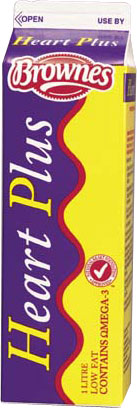
I am here to share with you the opportunities that exist with another healthful fatty acid group: The omega-3s. For starters, in early September FDA announced the availability of a qualified health claim linking consumption of the omega-3 fatty acids eicos-apentaenoic acid (EPA) and docosahexaenoic acid (DHA) via ordinary foods with reducing the risk of coronary heart disease (CHD).
Both EPA and DHA are contained in oily fish, such as salmon, lake trout, tuna and herring. These fatty acids are not essential to the diet; however, scientific evidence indicates that these fatty acids may be beneficial in reducing CHD.
"Coronary heart disease is a significant health problem that causes 500,000 deaths annually in the United States," says Lester Crawford, acting FDA commissioner. "This new qualified health claim for omega-3 fatty acids should help consumers as they work to improve their health by identifying foods that contain these important compounds."
The claim reads: Supportive but not conclusive research shows that consumption of EPA and DHA omega-3 fatty acids may reduce the risk of coronary heart disease. One serving of [name of food] provides [x]g of EPA and DHA omega-3 fatty acids. [See nutrition information for total fat, saturated fat and cholesterol content.]
In 2000, FDA announced a similar qualified health claim for dietary supplements containing EPA and DHA and the reduced risk of CHD. Further, FDA recommends that consumers not exceed more than a total of 3g per day of EPA and DHA, with no more than 2g daily from a dietary supplement.
Fish, fowl, eggs, baby formula and any other conventional foods that contain EPA and/or DHA can market the fat's heart-healthy effect. Today, consumers currently pay 15% to 20% more for baby formula enriched with omega-3 fatty acids. A similar opportunity exists with fluid milk beverages for certain demographic segments, particularly the aging baby boomer.
Take note, food manufacturers cannot simply add DHA and/or EPA to otherwise unhealthful products. With the exception of fish and dietary supplements, the agency requires that foods must be low in cholesterol (less than 20mg per serving) and low in saturated fat (less than 1g per serving and less than 15% calories from saturated fat) to add the health claim to their labels.
In Western Australia, PB Foods Ltd., recently rolled out Brownes Heart Plus, a specially formulated, low-fat milk containing added nutrients believed to be important for maintaining the performance of the heart and cardiovascular system. These nutrients are marine-derived omega-3 fatty acids and the vitamins B6, B12 and folate. Also, the antioxidant vitamins E and C are added so that the body can use the omega-3 nutrients efficiently.
Ireland's Dawn Dairies Ltd., now offers Omega Fresh Milk, which is made using a special dosing system that allows the omega-3s to be added to the whole and reduced-fat milk quickly and easily. Highly refined fish oil is used as it is said to be a more direct source of EPA and DHA than vegetable sources. Omega Fresh Milk is also fortified with vitamins A, D and E.
It is only a matter of time before similar products make their way into U.S. grocery stores. Add this to your R&D initiative list.